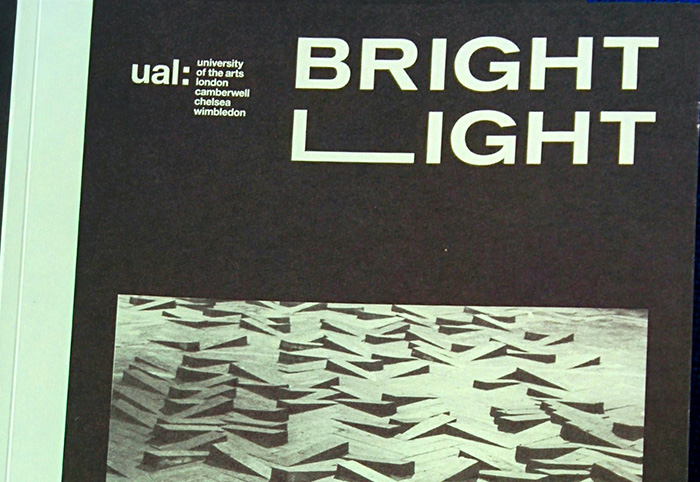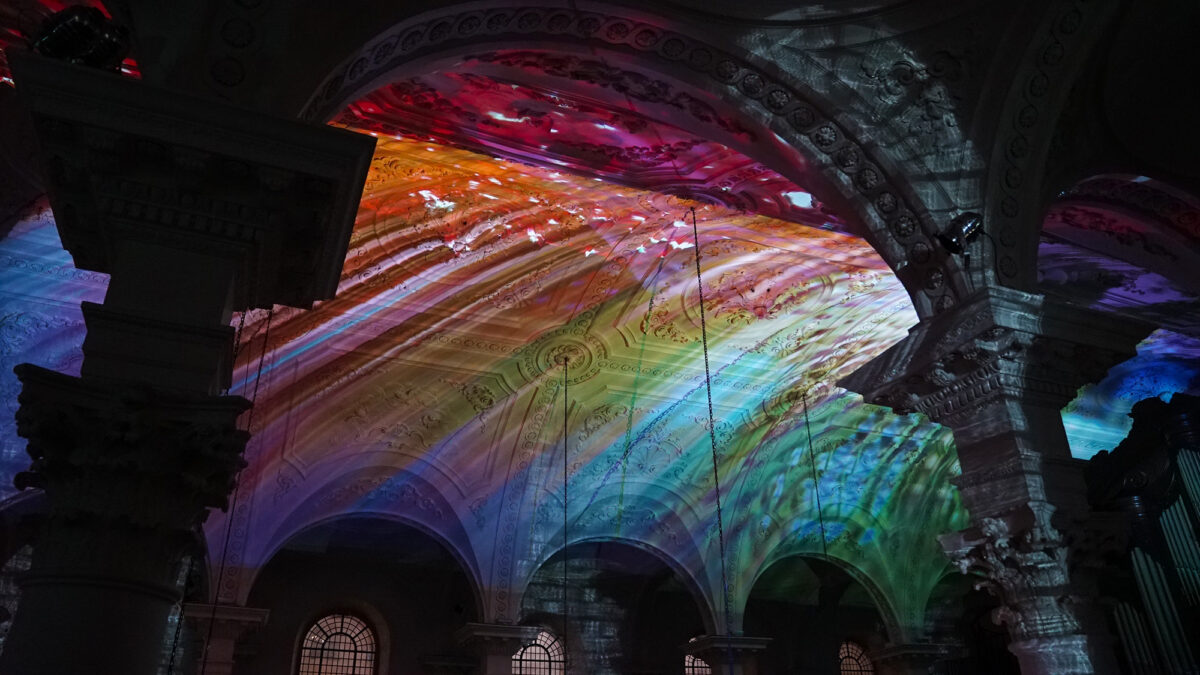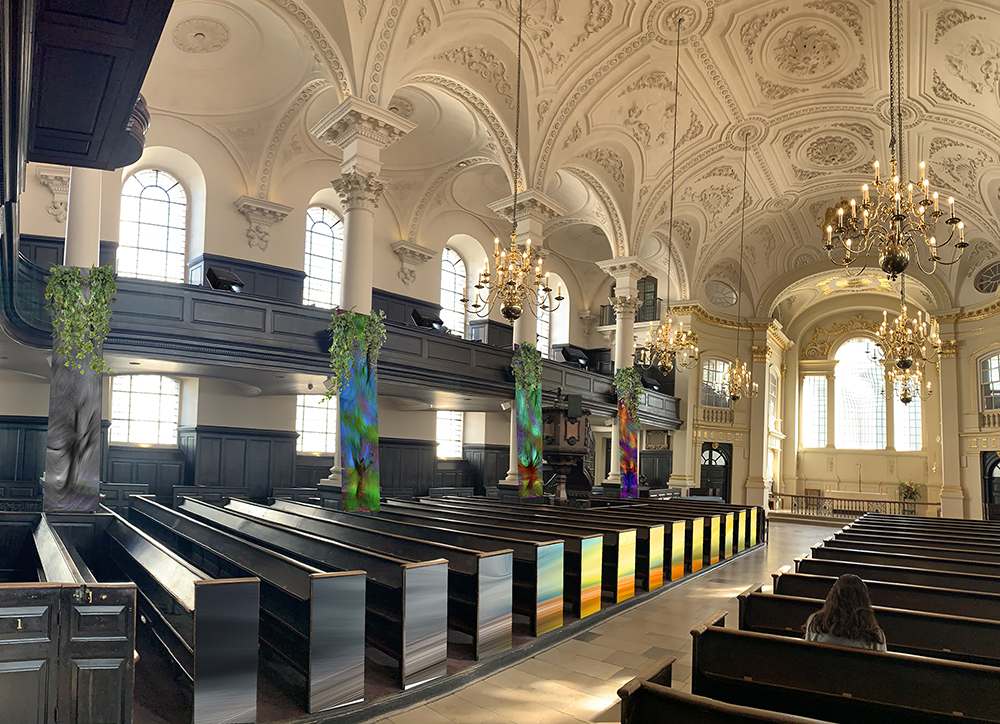A paper written for ‘Bright Light’ journal, 2016
A very early childhood memory is of being asked how many times I had breathed in the last 20 minutes. I still remember the shocked feeling that I did not know and indeed had never thought about it. In the fourth of his BBC Reith Lectures, Grayson Perry quoted a child who when asked what they thought an artist does, replied, ‘they notice things’ (2013, p.9). Maybe I’m being a bit harsh or unrealistic but why had I not noticed my breathing? Is it possible that sometimes the things we do, that are most important to life, like breathing, are the most unnoticed?
In my role as Course Leader for MA Fine Art Digital at Camberwell College of Arts, I emphasise (probably to an extent that annoys my students) the reflective process in learning and art making. The process of choosing to actively look at what you are doing andwho you are when doing it. More colloquial way of understanding reflection is suggested by James and Brookfield as ‘the way we “look back to go forward”’ (2014, p.27). The reflection process can be challenging. Maybe it is particularly hard to notice the most instinctive actions like breathing? This publication has asked for consideration of, a reflection on — inspiration and motivation, what drives forward or draws out the movement to make art and to facilitate the learning of students in making art. This ‘noticing’ has been strange a little like being asked how many times have you taken a breath since you started reading this?
So what? This reflective process has lead to this, a piece of writing that is speculative, hypothetical, debatable, attempting to link disparate quotes and ideas and making significant use of metaphor. At this point metaphor seems the only way to begin this exploration, therefore I present three somewhat unusual themes, ‘food’, ‘with’ and ‘noise’.
Food
In an essay ‘The Pleasures of Eating’ Wendell Berry (1990) eloquently points out the disconnect of most eating. He sees eating as the end of the ‘drama of the food economy’ that begins with planting, however he is disturbed by that fact that many people are now simply ‘passive consumers’. Food is processed and pre-cooked with the consumer oblivious to the any of the processes like growing, packaging and distributing the food. Talking about large food corporations, Berry scarily suggests, ‘they do not yet offer to insert it (food), prechewed, into our mouth … only because they have found no profitable way to do so.’ He then draws an analogy saying, ‘Like industrial sex, industrial eating has become a degraded, poor, and paltry thing.’
For Berry the classic passive consumer of food mostly finds on their plate,
‘inert, anonymous substances that have been processed, dyed, breaded, sauced, gravied, ground, pulped, strained, blended, prettified, and sanitized beyond resemblance to any part of any creature that ever lived.’
This, he argues, leads to a place of exile, for both the eater and the eaten. They are both in exile from any biological reality.
So what is the connection with art making? Is it too simple to replace the food industry with the ‘art industry’? Is the institution, whether academic or commercial (and is there a distinction anymore?), a negative force concealing a spreading passivity?
Berry suggests that the pleasure of eating starts with ‘reclaiming responsibility for one’s own part in the food economy’, eating takes place in the world it is ‘inescapably an agricultural act’.
Actions, however small and seemingly insignificant, matter. They express the complexity of something much greater. The small creative act, the choice to be aware of materials, the generous sharing in communities of learning — these insignificant acts are paradoxical in their subversiveness. They open the space for alternatives, they uncover complexity and don’t hide from ambiguity.
Twice a year our family host all the MA Fine Art Digital students for a meal at our home near to Camberwell College of Arts. A simple act of creating space for conversation. Around half of the 30+ students are online and can engage from anywhere in the world. Most come to London at least twice during the two years of the Masters course for a ‘Low Residency’, an intensive 10 days of workshops, visits, debates, discussions and collaborative making. These meals allow a relaxed place for face to face interaction across the more than 20 nations represented. But on reflection is it more than that? In carefully choosing and preparing food, even attempting to grow some of it myself in the summer months, is this part of telling a wider story, opening the horizon of learning? Can, or should, food, art and learning be a subversive, embodied and evocative act?
‘The pleasure of eating should be an extensive pleasure, not that of the mere gourmet. People who know the garden in which their vegetables have grown and know that the garden is healthy and remember the beauty of the growing plants, perhaps in the dewy first light of morning when gardens are at their best. Such a memory involves itself with the food and is one of the pleasures of eating. The knowledge of the good health of the garden relieves and frees and comforts the eater.’ (Berry, 1990)
What relieves and frees and comforts the art student?
With
An attempt to grasp the underlying sentiment of education can so often be swamped by money, metrics and markets. Art education attempts to justify itself using this language, persuading student and parent alike of its value in these three areas. With two sons at university and a third on his way I know too well the numbing process of ploughing through mostly insipid course websites and frankly useless KIS data.
A fundamental question sits largely unnoticed. When teaching in university are we; working forstudents; being forstudents; working withstudents; or being withstudents? In an in-depth critique of these four positions, the theologian and ethicist, Samuel Wells suggest that the first three actions, working for, being for and working with, are well understood and dangerously dominant. He argues that ‘being with’ is the area most neglected and yet the one most needed. He writes as someone working with some of the most disadvantaged communities in society, where the seemingly obvious thing is to ‘work for’ and ‘be for’ and ‘work with’ anyone whose voice is marginalised. However Wells’ counter-intuitive suggestion is that simply ‘being with’ is actually the most significant thing to do.
‘There is an honored place for working for and working with – and even, in the right circumstances, for being for – provided that each recognize they depend on, must almost always to some degree be preceded by, and always aim to issue in, being with’ (Wells, 2015, p.30)
In language rarely heard in the academic art world Wells challenges pre-conceived ideas of empowerment,
‘Being with does not start with a problem – or, if it does, the problem lies with ourselves, rather than with the person in whom we perceive scarcity. We do not sit and have a coffee with a homeless person because we are trying to solve their problem – we do so because we want to receive the wealth of wisdom, humanity, and grace that God has to give us through them. We are not the source of their salvation: they are the source of ours.’ (2015, p.29)
In many ways this is uncomfortable and strange, it asks questions about my role as artist and educator. Where is the power in the relationship? In whose interest is that power being used? As a Course Leader can I practice ‘with-ness’? Can the course structure encourage this sort of engagement amongst the students? Why would I want to? As I tentatively explore these questions, recognising a chord that rings true, even if I can’t fully articulate the constituent notes, it seems the tsunami of individualism that enthrones money, metrics and markets in education is the distraction. As Wells argues, ‘Being with is not a means to an end: it is an end in itself.’ He is very clear that this is not some strategy to enable more effective collaboration ‘it is an anticipation and a glimpse of the kind of interactions that may arise if the collaborative projects were to succeed.’ (2015, p.30)
I suggest that his use of words like, ‘anticipation’ and ‘glimpse’ create space for this speculation. These words feel right for my own art practice (and teaching practice) that is built on contingency, chance and improvisation. This might not fit comfortably with standard models of course design and curriculum delivery but maybe it is an approach that allows more space for openness and exploration? Is it a more fertile ground for the students to surprise me, to help shape my own learning? Does ‘being with’ diminish the role of the Course Leader/Programme Director or does it provide tools for breaking a model of scarcity and see limitless potential in generosity?
Noise
Claude Shannon wrote a Masters research paper in 1937 called ‘A Symbolic Analysis of Relay and Switching Circuits’. In his paper, Shannon showed that Boolean algebra could be used to construct an efficient switching circuit for increasingly complex telephone exchanges. By manipulating just two symbols ‘1’ and ‘0’ this work formed the basis for digital circuit design. Shannon’s ongoing research lead to another landmark paper in 1948, ‘A Mathematical Theory of Communication’. This paper was influential far beyond its initial mathematical and electrical engineering fields. It was the foundation for information theory that has seen applications in signal processing, data compression, cryptography, linguistics and biological modeling to name just a few. Shannon’s basic idea is summed up in this diagram:
(File: Shannon communication system.svg – Wikimedia commons, 2008)
In this model of communication noise is seen as the interference that impacts on a signal as it is transmitted from the source to the destination. Noise is detrimental to the purity of the original signal, potentially causing confusion and misunderstanding. The metaphor of ‘transmission’ or ‘transport’ has often been used in relation to communication, something is transported and any noise is simply seen as the enemy of this transmission.
Accepting that Shannon was simply concerned with an engineering problem rather than a semantic one, Daniel Chandler (1994) has pointed out the dangerously dominant position of the transport metaphor in information theory. Chandler suggests for example, this linear model ignores the two-way nature of communication, it lacks any feedback system and fails to take into account context, relationship or meaning.
In a digital environment noise is again seen as a dysfunctional factor. The digital tantalisingly dangles the potential for perfect copies and strives to avoid any interference. Photographic software provides noise reduction tools in an attempt to create a single pure image.
However, an alternative view, to seeing noise as a dysfunctional factor, is promoted by the theologian A.K.M Adam with his concept of ‘differential hermeneutics’ (2006). With its focus on text interpretation, hermeneutics is often concerned with correctness or legitimacy with the noise of divergent interpretations a distracting element. However Adam suggests that the deliberate study of interpretive difference means ‘we would be in a better position to characterize and weigh the differences among interpreters’ (2006, p.81). This would then create the space ‘in which difference, far from implying error on one or another part, constitutes a positive contribution toward a fuller understanding of textuality’ (2006, p81). This is not a pluralist position that lacks criticality, instead Adam suggests that ‘a differential hermeneutic permits practitioners to see in interpretive variety a sign of the variety in human imagination’ (2006, p.89) Therefore the potential confusion and weakness of difference can be seen as a strength and a ‘noisy peace of connected difference’ (Weinberger, 2010a) can be cultivated.
In facilitating a course that is specifically looking at the breadth of fine art practice but exploring what questions, challenges, difficulties and opportunities are presented by the digital environment, we often find ourselves, staff and students, in a very noisy space. Although some, like Eli Pariser with his concept of the ‘filter bubble’, would suggest that noise in a digital space is narrowed by algorithms so that ‘we’re more and more enclosed in our own bubbles’ (2012, p.4) and others like Andrew Keen (2015) would suggest difference is simply monopolised out by vast powerful corporations, the digital space is still often characterised by difference, a huge cornucopia of attitudes, perspectives and viewpoints. This is a very noisy space, a cacophony of different voices. However, the negotiation of this noise, navigating through the dissonance, seeking out notes, rhythms or chords that can be woven together into new melodies, is this not the human element breaking in? Is this the essence of a creative education? Encouraging exploration into a noisy unknown place feels a vital part of teaching. David Weinberger, in talking about how knowledge has been challenged in the digital age, captures some of the messiness (and exhilaration) of this approach. He suggests that we get to knowledge
‘by having desires and curiosity, through plotting and play, by being wrong more often than right, by talking with others and forming social bonds, by applying methods and then backing away from them, by calculation and serendipity, by rationality and intuition, by institutional processes and social roles. Most important in this regard, where the decisions are tough and knowledge is hard to come by, knowledge is not determined by information, for it is the knowing process that first decides which information is relevant, and how it is to be used.’ (Weinberger, 2010b)
Ending?
The subtitle ‘conclusion’ sounds too certain, too confident after thinking through such divergent metaphors. The opportunity to reflect and then write has been uncomfortable but useful. Being conscious of your own breathing can be an enlightening experience. Likewise with carefully considering the intuitive and the instinctive within teaching practice and to explore this through the lens of what moves, motivates and inspires has illuminated areas for further consideration. I sometimes say to my students that I won’t tell them what to do but I will try and ask questions so they can hear their own wisdom better. I have noticed that it can be hard to listen to yourself.
So it remains speculative, the hypothesis is unproven, the debate continues and the disparate links strive to connect. The core of art practice and teaching feels ambiguous, David Weinberger expresses this, ‘knowledge is more creative, messier, harder won, and far more discontinuous’ (Weinberger, 2010b). Can we extrapolate his use to ‘knowledge’ to include art making, teaching or the creative learning process, all of which have a messiness that challenges institutional structures? Using these 3 lenses of food, withand noiseto reflect on teaching and art practice I am conscious that ‘as a maker of art you are custodian of issues larger than self.’ (Bayles and Orland, 1993. p.108)Jonathan Kearney
Bibliography
Adam, A.K.M. (2006) Faithful interpretation: Reading the bible in a postmodern world. Minneapolis: Augsburg Fortress, Publishers.
Bayles, D. and Orland, T. (1993) Art & fear: Observations on the perils (and rewards) of Artmaking. 10th edn. Santa Cruz, CA: Image Continuum Press.
Berry, W. (1990) What are people for? Essays. 4th edn. San Francisco: North Point Press.
Chandler, D. (1994) Transmission model of communication. Available at: http://visual-memory.co.uk/daniel/Documents/short/trans.html (Accessed: 17 March 2016).
File: Shannon communication system.svg – Wikimedia commons (2008) Available at: https://commons.wikimedia.org/wiki/File:Shannon_communication_system.svg (Accessed: 17 March 2016).
James, A. and Brookfield, S.D. (2014) Engaging imagination: Helping students become creative and reflective thinkers. United States: John Wiley & Sons.
Keen, A. (2015) The Internet is not the answer. United Kingdom: Atlantic Books.
Pariser, E. (2012) The filter bubble: How the new personalized web is changing what we read and how we think. New York, NY: Penguin Group (USA).
Perry, G. (2013) Reith Lectures 2013: Playing to the Gallery. Available at: http://downloads.bbc.co.uk/radio4/transcripts/reith-lecture4-csm.pdf (Accessed: 20 March 2016).
Shannon, C. (1937) A Symbolic Analysis of Relay and Switching Circuits. Available at: https://dspace.mit.edu/bitstream/handle/1721.1/11173/34541425-MIT.pdf?sequence=2 (Accessed: 17 March 2016).
Shannon, C. (2008) File: Shannon communication system.svg Available at: https://en.wikipedia.org/wiki/File:Shannon_communication_system.svg (Accessed: 18 March 2016).
Shannon, C.E. and Weaver, W. (1963) The mathematical theory of communication. 4th edn. United States: University of Illinois Press.
Weinberger, D. (2010a) KM resources. Available at: http://www.kmworld.com/Articles/Column/David-Weinberger/The-Internet-and-peace-61172.aspx (Accessed: 17 March 2016).
Weinberger, D. (2010b) The problem with the data-information-knowledge-wisdom hierarchy. Available at: https://hbr.org/2010/02/data-is-to-info-as-info-is-not (Accessed: 17 March 2016).
Wells, S. (2015) A Nazareth manifesto: Being with god. United States: Wiley-Blackwell.


